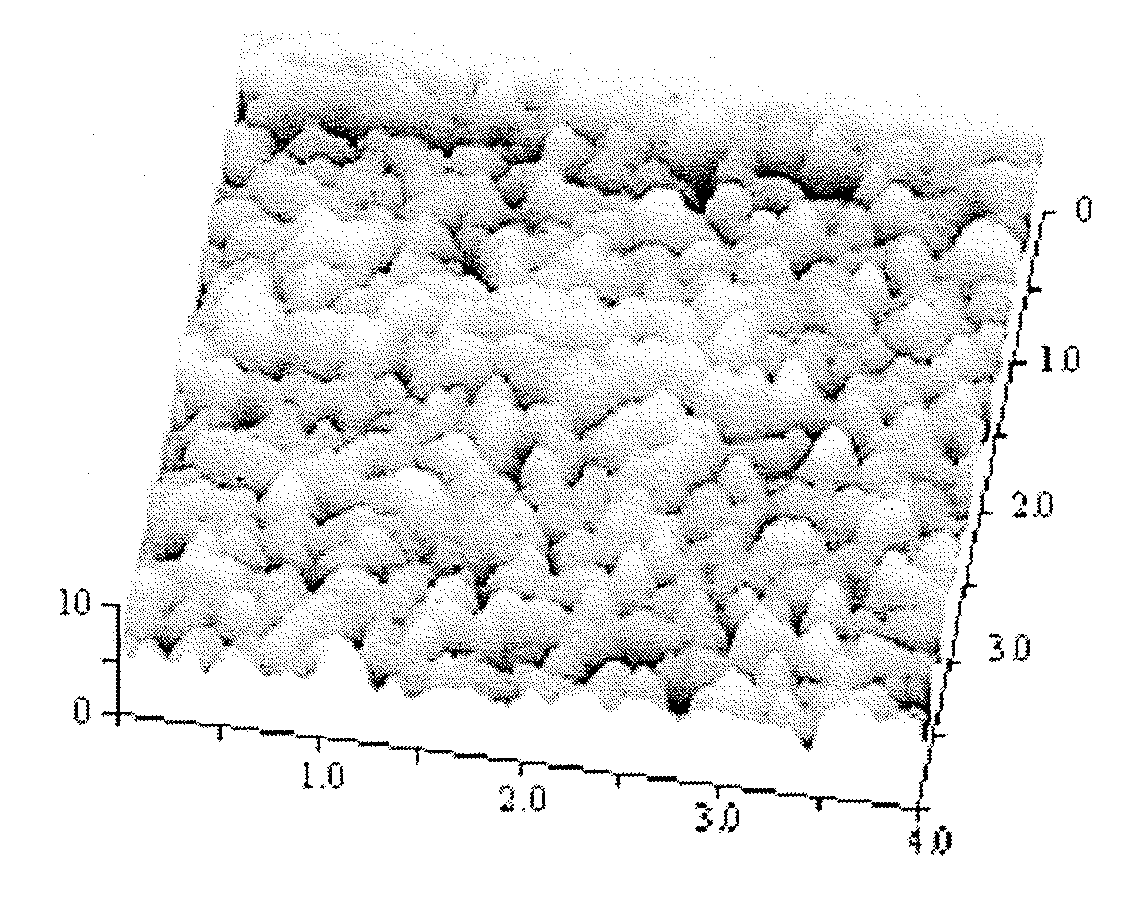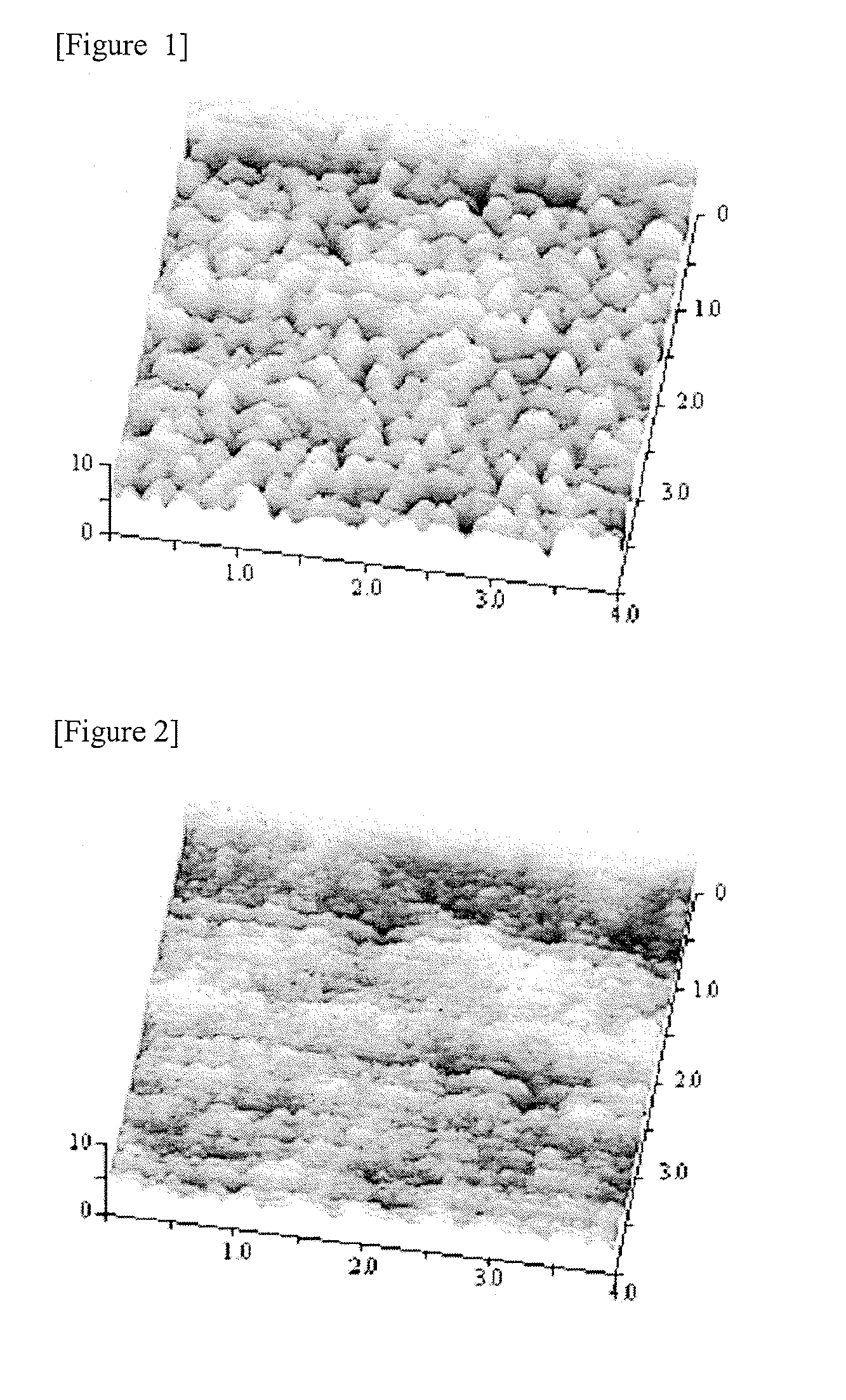Method For Modifying Surface Of Substrate, Substrate Having Modified Surface, And Method For Producing Same
a technology of modified surface and substrate, which is applied in the direction of liquid/solution decomposition chemical coating, light beam reproducing, instruments, etc., can solve the problems of inferior abrasion resistance, insufficient hydrophilicity of formed silica layer, and insufficient hydrophilicity of substrate obtained by these methods, so as to achieve excellent hydrophilicity, excellent hydrophilicity, abrasion resistance, chemical resistance, the effect of producing such substrates is efficient and simpl
- Summary
- Abstract
- Description
- Claims
- Application Information
AI Technical Summary
Benefits of technology
Problems solved by technology
Method used
Image
Examples
working example 1
[0098]The surface (contact angle with water: 79 degrees) of a test plate made of stainless steel [SUS304] was coated with a xylene solution of perhydropolysilazane comprising —(SiH2—NH)— as the repeating unit (a product of Clariant Japan, product name: NP-110, containing an amine-type catalyst) in a concentration of 2% by weight, where the coated amount was an amount sufficient to form a perhydropolysilazane coating with a thickness of from 100 to 180 nm. The coated test plate was left to stand for air-drying. Immediately after removal of the xylene, a xylene solution of polyethyleneglycol (the number average molecular weight, hereinafter referred to as Mw: 600) in a concentration of 2% by weight was coated onto the perhydropolysilazane coating, and the resulting coated test plate was left to stand in atmosphere at room temperature for one hour followed by being put into an electrical chamber to heat it for 30 minutes in 150° C. air.
[0099]After cooling, distilled water was streamed ...
working example 2
[0100]The surface (contact angle with water: 79 degrees) of a test plate made of stainless steel [SUS304] was coated with a xylene solution of perhydropolysilazane comprising —(SiH2—NH)— as the repeating unit (a product of Clariant Japan, product name: NP-110, containing an amine-type catalyst) in a concentration of 2% by weight, where the coated amount was an amount sufficient to form a perhydropolysilazane coating with a thickness of 100 to 180 nm. The coated test plate was left to stand for air-drying. Immediately after removal of the xylene, a xylene solution of polyethyleneglycol (Mw: 200) in a concentration of 2% by weight was coated onto the perhydropolysilazane coating, and the resulting coated test plate was left to stand in atmosphere at room temperature for one hour followed by being put into an electrical chamber to heat it for 30 minutes in 150° C. air.
[0101]After cooling, distilled water was streamed over the surface of a silica layer of this test panel to wash down th...
working example 3
[0102]The surface (contact angle with water: 79 degrees) of a test plate made of stainless steel [SUS304] was coated with a xylene solution of perhydropolysilazane comprising —(SiH2—NH)— as the repeating unit (a product of Clariant Japan, product name: NP-110, containing an amine-type catalyst) in a concentration of 2% by weight, where the coated amount was an amount sufficient to form a perhydropolysilazane coating with a thickness of 100 to 180 nm. The coated test plate was left to stand for air-drying. Immediately after removal of the xylene, a xylene solution of polyethyleneglycol (Mw: 100) in a concentration of 2% by weight was coated onto the perhydropolysilazane coating, and the resulting coated test plate was left to stand in atmosphere at room temperature for one hour followed by being put into an electrical chamber to heat it for 30 minutes in 150° C. air.
[0103]After cooling, distilled water was streamed over the surface of a silica layer of this test panel to wash down th...
PUM
| Property | Measurement | Unit |
|---|---|---|
| thickness | aaaaa | aaaaa |
| contact angle | aaaaa | aaaaa |
| domain structure | aaaaa | aaaaa |
Abstract
Description
Claims
Application Information
 Login to View More
Login to View More - R&D
- Intellectual Property
- Life Sciences
- Materials
- Tech Scout
- Unparalleled Data Quality
- Higher Quality Content
- 60% Fewer Hallucinations
Browse by: Latest US Patents, China's latest patents, Technical Efficacy Thesaurus, Application Domain, Technology Topic, Popular Technical Reports.
© 2025 PatSnap. All rights reserved.Legal|Privacy policy|Modern Slavery Act Transparency Statement|Sitemap|About US| Contact US: help@patsnap.com



